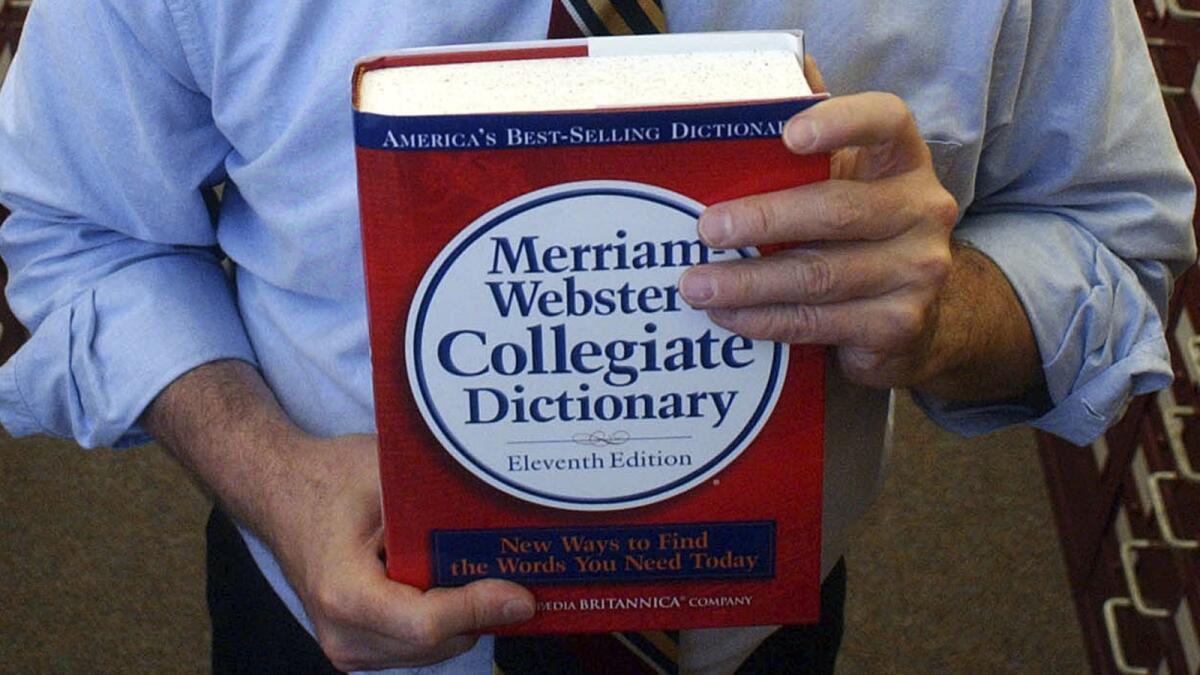Opinion: The rightness of the singular âtheyâ

The venerable Merriam-Webster dictionary has declared the word âtheyâ its 2019 word of the year. The singular they and its many supporters have won and itâs here to stay. Despite what many language skeptics think, the use of they as a gender-neutral singular pronoun is no mistake; it goes back to the 14th century.
For decades, transgender rights advocates have noted that literary giants Emily Dickinson, William Shakespeare, William Wordsworth, and Geoffrey Chaucer all used singular they in their writing. In a letter dated Sept. 24, 1881, Dickinson wrote: âAlmost anyone under the circumstances would have doubted if [the letter] were theirs, or indeed if they were themself â but to us it was clear.â In âHamlet,â Shakespeare used âthemâ in reference to the word mother: ââTis meet that some more audience than a mother â Since nature makes them partial â should oâerhear the speech.â
Even the most strident grammarians give pause when faced with evidence that singular they has long been a tool of the trade. Activists have also emphasized that singular they is used all the time in speaking and writing when we donât know or donât want to specify the gender of the subject â as in recent commentary about the whistleblower in the Trump impeachment inquiry.
The current usage of the singular they, however, has expanded beyond the historical precedent. A few months before declaring they the word of the year, Merriam-Webster added a new definition to the word: âused to refer to a single person whose gender identity is nonbinary.â Some might view this change as happening too quickly, but it has been a long time coming.
For hundreds of years, pronouns were used to denigrate trans, nonbinary and gender-nonconforming people â especially in the press. When George Wilson, a Scottish immigrant worker, was hauled into the police station in New Yorkâs Lower East Side in 1836 for being both drunk and trans, a reporter for the Journal of Commerce described them using female pronouns from start to finish, stating: âWhen she arrived there, she went to work in a factory, still retaining her boyâs dress,â despite the fact they lived and worked as a man and were legally married as a man to a woman.
For decades, the transgender community has fought back against this misgendering, using its own publications as a place to critique mainstream newspaper practices and model gender expansive and inclusive language. When Brandon Teena was brutally assaulted and murdered in Nebraska in 1993, headlines were sensational and transphobic. One from the Orlando Sentinel on Jan. 4, 1994, read: âShe lived as a man but died a woman.â
In an effort to reclaim Brandonâs story for the community in a respectful way that honored Brandonâs life, Forrest Wolf, a writer for âTransgender Tapestry,â reprinted excerpts from news reports with the misgendering crossed out. Wolf explained: â[PLEASE NOTE that the strike through is a rhetorical device utilized to indicate that a particular word (in this case the pronouns she and her used in connection with Brandon) is deemed by the writer as inappropriate, contradictory or questionable and shows no meaningful or authentic correspondence to that which it refers.â In death, as in life, pronouns matter.
No single author or activist did more to challenge the binary gender in language and publishing than Leslie Feinberg. Feinberg insisted on using âs/heâ and âhirâ pronouns on the jacket of their 1996 book âTransgender Warriors.â Feinberg was breaking new ground and knew it, stating: âItâs the first time that I know of that any publisher has used that for an author.â Their reason was simple, as they stated: âNeither she or he can adequately address my experience, and the pronoun it has been used to dehumanize us as trans people.â
A decade later in 2006, trans author S. Bear Bergman chose âzeâ and âhirâ as the gender-neutral pronouns to anchor their book, âButch is a Noun.â Bergman explains the decision this way: âBy using gender-neutral pronouns in this book ... I am trying to open up a space in the language for people who are not man- or woman-gendered.â
In researching and writing my forthcoming book on trans history, I quickly realized that I needed to use gender neutral pronouns in reference to everyone who transitioned in some way. I settled on âthey/them/theirâ and told the editors this was nonnegotiable. Much to my surprise and in contrast to earlier experiences in publishing historical writing with the singular they, my manuscript sailed through the editing process. Merriam-Websterâs acclamation for they is an important standardization that further secures the idea in the cultural mainstream.
The dictionary matters because language matters. As history shows, language is a very powerful tool. It can dehumanize and erase. It can empower and render visible. It doesnât take much to get it right. Iâm sure Emily Dickinson would approve.
Jen Manion is an associate professor of history at Amherst College and author of the forthcoming âFemale Husbands: a Trans History.â
More to Read
A cure for the common opinion
Get thought-provoking perspectives with our weekly newsletter.
You may occasionally receive promotional content from the Los Angeles Times.










